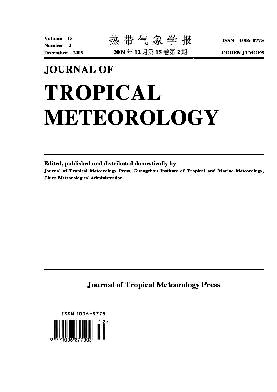|
[1]
|
CHEN Lian-shou, LUO Zhe-xian, LI Ying. Researchadvances on tropical cyclone landfall process [J]. Acta Meteor.Sinica (in Chinese), 2004, 62(5): 541-549. |
|
[2]
|
ZHANG Hai-xia, CUI Xiao-peng, KANG Feng-qin, et al.Observational analysis for a torrential rain caused by a landfalltyphoon [J]. Plateau Meteor. (in Chinese), 2007, 26(5):980-991. |
|
[3]
|
ZHAO Yu, CUI Xiao-peng, WANG Jian-guo. A study on aheavy rainfall event triggered by inverted typhoon trough inShandong province [J]. Acta Meteor. Sinica (in Chinese), 2008,66(3): 423-436. |
|
[4]
|
GAO S T, CUI X P, ZHU Y S, et al. Surface rainfallprocesses as simulated in a cloud resolving model [J]. J.Geophys. Res., 2005, 110, D10202, doi:10.1029/2004JD005467. |
|
[5]
|
CUI X P, LI X F. Role of surface evaporation in surfacerainfall processes [J]. J. Geophys. Res., 2006, 111, D17112,doi: 10.1029/2005JD006876. |
|
[6]
|
GAO S T, PING F, LI X F. Cloud microphysical processesassociated with the diurnal variations of tropical convection: A2D cloud resolving modeling study [J]. Meteor. Atmos. Phys.,2006, 91: 9-16. |
|
[7]
|
GAO S T, PING F, CUI X P, et al. Short timescale air-seacoupling in the tropical deep convective regime [J]. Meteor.Atmos. Phys., 2006, 93: 37-44. |
|
[8]
|
GAO S T. A three dimensional dynamic vorticity vectorassociated with tropical oceanic convection [J]. J. Geophys.Res., 2007, 113, doi: 10.1029/2006JD008247. |
|
[9]
|
CUI X P, ZHOU Y S, LI X F. Cloud MicrophysicalProperties in Tropical Convective and Stratiform Regions [J].Meteor. Atmos. Phys., 2007, 98: 1-11. |
|
[10]
|
SUI C H, LI X F, YANG M J. On the definition ofprecipitation efficiency [J]. J. Atmos. Sci., 2007, 64(12):4506-4513. |
|
[11]
|
GAO S T, LI X F. Cloud-resolving modeling ofconvective processes [M]. 2008, Dordrecht: Springer, 206 pp. |
|
[12]
|
CUI X P. A Cloud-Resolving Modeling Study of DiurnalVariations of Tropical Convective and Stratiform Rainfall [J].J. Geophys. Res., 2008, 113, D02113, doi:10.1029/2007JD008990. |
|
[13]
|
CUI Xiao-peng, LI Xiao-fan, ZONG Zhi-ping. Cloudmicrophysical and Rainfall Responses to Zonal Perturbationsof Sea Surface Temperature: A Cloud-Resolving ModelingStudy [J]. Prog. Nat. Sci., 2009, 19(5): 587-594. |
|
[14]
|
GAO Shou-ting, CUI Xiao-peng, LI Xiao-fan. A modelingStudy of Diurnal Rainfall Variations during the 21-Day Periodof TOGA COARE [J]. Adv. Atmos. Sci., 2009, 26(5):895-905. |
|
[15]
|
CUI Xiao-peng. Quantitative diagnostic analysis ofsurface rainfall processes by surface rainfall equation [J]. Chin.J. Atmos. Sci. (in Chinese), 2009, 33(2): 375-387. |
|
[16]
|
GRABOWSKI W W, WU X Q, MONCRIEFF M W.Cloud-resolving model of tropical cloud systems during PhaseIII of GATE. Part I: Two dimensional experiments [J]. J.Atmos. Sci., 1996, 53(24): 3684-3709. |
|
[17]
|
LI X F, SUI C H, LAU K M, et al. Large-scale forcingand cloud-radiation interaction in the tropical deep convectiveregime [J]. J. Atmos. Sci., 1999, 56(17): 3028-3042. |
|
[18]
|
WANG J J, LI X F, CAREY L. Evolution, structure,cloud microphysical and surface rainfall processes of amonsoon convection during the South China Sea MonsoonExperiment [J]. J. Atmos. Sci., 2007, 64(2): 360-380. |
|
[19]
|
XU X F, XU F W, LI B. A cloud-resolving modelingstudy of a torrential rainfall event over China [J]. J. Geophys.Res., 2007, 112, D17204, doi: 10.1029/2006JD008275. |
|
[20]
|
SUI C H, LAU K M, TAO W K, et al. The tropicalwater and energy cycles in a cumulus ensemble model. Part I:Equilibrium climate [J]. J. Atmos. Sci., 1994, 51(5): 711-728. |
|
[21]
|
SUI C H, LI X F, LAU K M. Radiative-convectiveprocesses in simulated diurnal variations of tropical oceanicconvection [J]. J. Atmos. Sci., 1998, 55(13): 2345-2357. |
|
[22]
|
RUTLEDGE S A, HOBBS P V. The mesoscale andmicroscale structure and organization of clouds and precipitation in midlatitude cyclones. Part VIII: A model forthe "seeder-feeder" process in warm-frontal rainbands [J]. J.Atmos. Sci., 1983, 40(5): 1185-1206. |
|
[23]
|
RUTLEDGE S A, HOBBS P V. The mesoscale andmicroscale structure and organization of clouds andprecipitation in midlatitude cyclones. Part XII: A diagnosticmodeling study of precipitation development in narrowcold-frontal rainbands [J]. J. Atmos. Sci., 1984, 41(20):2949-2972. |
|
[24]
|
LIN Y L, FARLEY R D, ORVILLE H D. Bulkparameterization of the snow field in a cloud model [J]. J.Appl. Meteor., 1983, 22(6): 1065-1092. |
|
[25]
|
TAO W K, SIMPSON J, MCCUMBER M. An ice-watersaturation adjustment [J]. Mon. Wea. Rev., 1989, 117(1):231-235. |
|
[26]
|
KRUEGER S K, FU Q, LIOU K N, et al. Improvement ofan ice-phase microphysics parameterization for use innumerical simulations of tropical convection [J]. J. Appl.Meteor., 1995, 34(1): 281-287. |
|
[27]
|
CHOU M D, SUAREZ M J, HO C H, et al.Parameterizations for cloud overlapping and shortwave singlescattering properties for use in general circulation and cloudensemble models [J]. J. Climate, 1998, 11(2): 202-214. |
|
[28]
|
CHOU M D, KRATZ D P, RIDGWAY W. Infraredradiation parameterization in numerical climate models [J]. J.Climate, 1991, 4(4): 424-437. |
|
[29]
|
CUI Xiao-peng. A phase analysis of vorticity vectorsassociated with tropical convection [J]. Chin. Phys., 2008,17(6): 2304-2307. |
|
[30]
|
CUI Xiao-peng, GAO Shou-ting. Effects of zonalperturbations of sea surface temperature on tropicalequilibrium states: A cloud-resolving modeling study [J]. Prog.Nat. Sci., 2008, 18(4): 413-419. |
|
[31]
|
GAO S T, CUI X P, ZHOU Y S, et al. A Modeling studyof moist and dynamic vorticity vectors associated with 2dtropical convection [J]. J. Geophys. Res., 2005, 110, D17104,doi: 10.1029/2004JD005675. |
|
[32]
|
GAO Shou-ting, CUI Xiao-peng, LI Xiao-fan. A modelingstudy of relation between cloud amount and SST over westerntropical Pacific cloudy regions during TOGA COARE [J]. Prog.Nat. Sci., 2009, 19(2): 187-193. |
|
[33]
|
GAO S T, PIN F, LI X F, et al. A convective vorticityvector associated with tropical convection: A two-dimensionalcloud-resolving modeling study [J]. J. Geophys. Res., 2004,109, D14106, doi: 10.1029/2004JD004807. |
|
[34]
|
CANIAUX G, REDELSPERGER J L, LAFORE J P. Anumerical study of the stratiform region of a fast-movingsquall line. Part I: General description and water and heatbudgets [J]. J. Atmos. Sci., 1994, 51(14): 2046-2074. |
|
[35]
|
STEINER M, HOUZE R A, YUTER S E. Climatologicalcharacterization of three-dimensional storm structure fromoperational radar and rain gauge data [J]. J. Appl. Meteor.,1995, 34(9): 1978-2007. |
|
[36]
|
TAO W K, LANG S, SIMPSON J, et al. Retrievalalgorithms for estimating the vertical profiles of latent heatrelease: Their applications for TRMM [J]. J. Meteor. Soc.Japan, 1993, 71(6): 685-700. |
|
[37]
|
XU K M. Partitioning mass, heat, and moisture budgetsof explicitly simulated cumulus ensembles into convective andstratiform components [J]. J. Atmos. Sci., 1995, 52(5):551-573. |
|
[38]
|
LANG S, TAO W K, SIMPSON J, et al. Modeling ofconvective-stratiform precipitation processes: Sensitivity topartition methods [J]. J. Appl. Meteor., 2003, 42(4): 505-527. |
|
[39]
|
KUO H L. On formation and intensification of tropicalcyclones through latent heat release by cumulus convection [J].J. Atmos. Sci., 1965, 22(1): 40-63. |
|
[40]
|
KUO H L. Further studies of the parameterization of theinfluence of cumulus convection on large-scale flow [J]. J.Atmos. Sci., 1974, 31(5): 1232-1240. |

















 粤公网安备 4401069904700002号
粤公网安备 4401069904700002号
 DownLoad:
DownLoad: